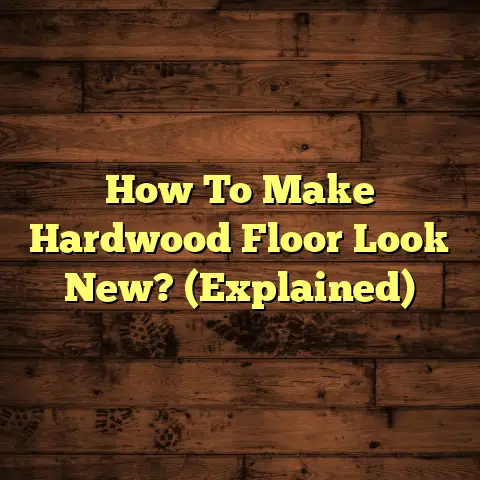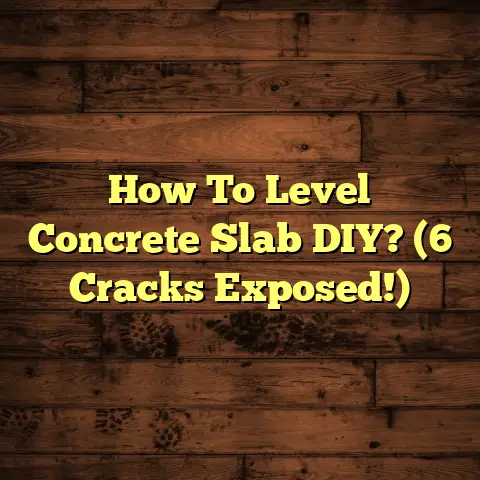Self-Adhesive Vinyl Review? (1 Pro Reveals!)
In today’s world, technology has completely revolutionized how we manage our homes. It’s all about efficiency, convenience, and creating a space that’s not only functional but also a reflection of our modern lifestyles.
Choosing the right flooring is a HUGE part of that. It’s not just about aesthetics; it’s about how your flooring interacts with your smart home ecosystem. Think about it: easy to clean surfaces for those inevitable spills during movie night, or flooring that complements your smart lighting system.
That’s where self-adhesive vinyl flooring comes in. I’ve been a flooring contractor for over 15 years, and I’ve seen trends come and go. But self-adhesive vinyl? It’s got staying power, especially in the context of smart homes. It’s practical, stylish, and surprisingly easy to work with. Let’s dive in and see why!
Section 1: What is Self-Adhesive Vinyl Flooring?
So, what exactly is self-adhesive vinyl flooring? Well, simply put, it’s a type of vinyl flooring that comes with an adhesive backing. Think of it like a giant sticker for your floor.
Unlike traditional vinyl flooring, which usually requires glue or professional installation, self-adhesive vinyl is designed for easy, DIY installation. This makes it a popular choice for homeowners looking to upgrade their space without breaking the bank or hiring a contractor (though, full disclosure, I might be a little biased against that!).
Composition and Manufacturing
Let’s talk about what this stuff is made of. Self-adhesive vinyl flooring typically consists of several layers:
-
Wear Layer: This is the top layer, and it’s what protects the flooring from scratches, stains, and wear. The thicker the wear layer, the more durable the flooring. I generally recommend a wear layer of at least 12 mils (that’s about 0.012 inches) for high-traffic areas.
-
Print Layer: This layer contains the design or pattern of the flooring. Thanks to modern printing technology, you can find self-adhesive vinyl that looks like wood, stone, tile, or just about anything else you can imagine.
-
Vinyl Core: This is the main body of the flooring, providing stability and cushioning.
-
Adhesive Layer: This is the magic layer! It’s a pressure-sensitive adhesive that sticks to the subfloor. It’s usually protected by a release liner that you peel off before installation.
The manufacturing process involves layering these materials and then applying heat and pressure to bond them together. The quality of the materials and the manufacturing process directly affect the durability and longevity of the flooring.
Designs, Colors, and Patterns
One of the things I love most about self-adhesive vinyl is the sheer variety of options available. Whether you’re going for a rustic farmhouse look, a sleek modern vibe, or something in between, you can find a self-adhesive vinyl that fits your style.
You can find options that mimic hardwood planks, ceramic tiles, or even natural stone. And the color options are virtually endless. I’ve seen everything from classic oak and maple to trendy gray and even bold, geometric patterns.
Here’s a quick rundown of some popular styles:
-
Wood-Look Planks: These are designed to look like real hardwood flooring, complete with wood grain textures and realistic color variations.
-
Tile-Look Squares: These mimic the look of ceramic or porcelain tiles, often with grout lines printed on the surface for added realism.
-
Stone-Look Tiles: These replicate the look of natural stone, such as marble, slate, or travertine.
-
Decorative Patterns: For a bolder look, you can find self-adhesive vinyl with geometric patterns, floral designs, or other eye-catching motifs.
Section 2: The Benefits of Self-Adhesive Vinyl Flooring
Okay, so we know what self-adhesive vinyl flooring is. But why should you consider it for your smart home? Let’s break down the benefits.
Ease of Installation: DIY-Friendly Flooring
This is the big one. One of the main reasons people choose self-adhesive vinyl is because it’s so easy to install. You don’t need any special tools or skills, and you can usually complete a room in a weekend.
Here’s a quick overview of the installation process:
-
Prepare the Subfloor: This is crucial. The subfloor needs to be clean, level, and dry. I usually recommend sweeping, vacuuming, and then wiping down the subfloor with a damp mop. If there are any imperfections, like cracks or holes, you’ll need to fill them in with a patching compound.
-
Acclimate the Flooring: Let the vinyl planks or tiles sit in the room for at least 24 hours before installation. This allows them to adjust to the room’s temperature and humidity, which can prevent warping or buckling later on.
-
Plan Your Layout: Before you start sticking anything down, take some time to plan your layout. Start by finding the center of the room and working outward. This will help ensure that the flooring is symmetrical and that you don’t end up with small, awkward pieces along the edges.
-
Peel and Stick: Peel off the release liner from the back of the vinyl plank or tile and carefully position it on the subfloor. Press firmly to ensure that it adheres properly.
-
Cut and Fit: You’ll probably need to cut some of the planks or tiles to fit around walls, doorways, and other obstacles. Use a utility knife and a straightedge for clean, precise cuts.
Pro Tip: Use a rolling pin or a floor roller after installation to ensure that the adhesive is fully bonded to the subfloor.
Cost-Effectiveness: Budget-Friendly Flooring
Compared to other flooring options like hardwood, tile, or carpet, self-adhesive vinyl is generally much more affordable. Not only is the material itself cheaper, but you’ll also save money on installation costs since you can do it yourself.
Here’s a rough cost comparison:
| Flooring Type | Average Cost per Square Foot (Material Only) | Average Installation Cost per Square Foot |
|---|---|---|
| Self-Adhesive Vinyl | \$1 – \$4 | \$0 (DIY) |
| Traditional Vinyl | \$2 – \$5 | \$1 – \$3 |
| Laminate | \$2 – \$8 | \$2 – \$5 |
| Hardwood | \$5 – \$15 | \$4 – \$8 |
| Tile | \$3 – \$20 | \$5 – \$10 |
| Carpet | \$2 – \$8 | \$1 – \$3 |
As you can see, self-adhesive vinyl is one of the most budget-friendly options available.
Durability and Maintenance: Long-Lasting and Easy to Clean
Don’t let the low price fool you – self-adhesive vinyl can be surprisingly durable. With proper care, it can last for 10-20 years, or even longer.
The wear layer is what protects the flooring from scratches, stains, and wear. A thicker wear layer will provide better protection.
Self-adhesive vinyl is also very easy to clean and maintain. Regular sweeping or vacuuming is usually all that’s needed to keep it looking its best. For spills and stains, you can simply wipe them up with a damp cloth or mop.
Pro Tip: Avoid using harsh chemicals or abrasive cleaners, as these can damage the wear layer.
Many manufacturers offer warranties on their self-adhesive vinyl flooring. Be sure to read the warranty carefully before you buy, as it may have specific requirements for installation and maintenance.
Comfort and Safety: Soft Underfoot and Slip-Resistant
Unlike hard flooring options like tile or stone, self-adhesive vinyl is relatively soft and comfortable underfoot. This can be a big plus if you spend a lot of time standing in the kitchen or other areas of your home.
Some self-adhesive vinyl flooring also has slip-resistant properties, which can help prevent accidents. This is especially important in areas like bathrooms and kitchens, where spills are common.
Eco-Friendly Options: Sustainable Flooring
If you’re concerned about the environment, you’ll be happy to know that there are eco-friendly self-adhesive vinyl options available. These products are typically made from recycled materials and are low in VOCs (volatile organic compounds).
Look for certifications like FloorScore or GreenGuard to ensure that the flooring meets strict environmental standards.
Section 3: Real-Life Applications in Smart Homes
Okay, let’s get practical. How does self-adhesive vinyl actually work in a smart home?
I’ve seen it used in a variety of ways, and I’ve always been impressed with the results.
Case Studies and Examples
I recently worked on a project for a client who was renovating their entire home to be a fully integrated smart home. They wanted flooring that was not only stylish but also durable and easy to maintain.
We ended up using wood-look self-adhesive vinyl planks in the living room, kitchen, and bedrooms. The planks looked fantastic, and they perfectly complemented the home’s modern aesthetic. The client was especially happy with how easy the flooring was to clean, especially with their two young children.
Another client used tile-look self-adhesive vinyl in their bathroom. They were able to install it themselves in a weekend, saving a significant amount of money on installation costs. The flooring looked great, and it was also slip-resistant, which was a major concern for them.
Complementing Smart Home Technology
Self-adhesive vinyl flooring can also complement smart home technology in a variety of ways. For example, if you have smart lighting, you can choose a flooring color and pattern that enhances the lighting effects.
If you have a smart thermostat, you can choose a flooring option that helps to insulate the room and maintain a consistent temperature.
Testimonials and Quotes
Here are a few quotes from homeowners and interior designers who have used self-adhesive vinyl in their projects:
-
“I was amazed at how easy it was to install self-adhesive vinyl flooring. I did it myself in a weekend, and it looks fantastic!” – Sarah J., Homeowner
-
“Self-adhesive vinyl is a great option for budget-conscious homeowners who want to upgrade their flooring without sacrificing style or quality.” – Mark L., Interior Designer
-
“I love how easy it is to clean self-adhesive vinyl flooring. It’s perfect for my busy family.” – Jessica R., Homeowner
Section 4: Challenges and Drawbacks
Okay, let’s be real. No flooring option is perfect, and self-adhesive vinyl is no exception. While it has many benefits, there are also some potential drawbacks to consider.
Potential Peeling
One of the biggest concerns with self-adhesive vinyl is the potential for peeling. This can happen if the subfloor is not properly prepared, if the adhesive is not strong enough, or if the flooring is exposed to excessive moisture.
To prevent peeling, it’s crucial to prepare the subfloor properly. Make sure it’s clean, level, and dry. You may also want to consider using a primer to improve adhesion.
Limitations on Subflooring
Self-adhesive vinyl is not suitable for all types of subflooring. It’s generally best to install it over a smooth, solid surface like concrete or plywood. It’s not recommended for use over carpet, cushioned vinyl, or uneven surfaces.
Importance of Proper Installation
Proper installation is crucial for the success of any flooring project, but it’s especially important with self-adhesive vinyl. If the flooring is not installed correctly, it can peel, buckle, or otherwise fail.
Be sure to follow the manufacturer’s instructions carefully, and don’t hesitate to ask for help if you’re not sure about something.
Situations Where It May Not Be the Best Choice
Self-adhesive vinyl is not always the best choice for every situation. For example, it’s not recommended for use in high-moisture areas like bathrooms or laundry rooms, unless it’s specifically designed for that purpose.
It’s also not the best choice for areas that are subject to heavy traffic or abuse, as it may not be durable enough to withstand the wear and tear.
Section 5: Expert Opinion
To get an even more in-depth perspective, I spoke with renowned interior designer, Emily Carter, who specializes in smart home renovations. Here’s what she had to say:
Me: Emily, what are your general thoughts on self-adhesive vinyl flooring in the context of smart homes?
Emily: “I think it’s a fantastic option for many homeowners. It offers a great balance of affordability, style, and ease of installation. In a smart home, where technology often takes center stage, self-adhesive vinyl allows homeowners to achieve a modern, clean look without breaking the bank.”
Me: What are some trends you’re seeing in the industry regarding flooring choices?
Emily: “We’re seeing a huge shift towards sustainable and eco-friendly materials. Homeowners are also looking for flooring that’s easy to maintain and clean, especially with the rise of smart cleaning devices like robot vacuums. Self-adhesive vinyl, particularly the eco-friendly options, fits right into these trends.”
Me: Any advice for homeowners considering self-adhesive vinyl for their smart home?
Emily: “Absolutely! First, don’t skimp on the subfloor preparation. A smooth, level surface is key to a successful installation. Second, consider the overall aesthetic of your smart home. Choose a color and pattern that complements your existing décor and smart lighting systems. And finally, don’t be afraid to mix and match. You can use self-adhesive vinyl in some areas of your home and other flooring options in others to create a unique and personalized look.”
Conclusion
So, there you have it – a comprehensive look at self-adhesive vinyl flooring. As I’ve shown you, it’s an ideal choice for modern smart homes.
It blends practicality with aesthetic appeal seamlessly, and it aligns perfectly with current home technology trends. From its ease of installation to its cost-effectiveness and durability, self-adhesive vinyl offers a compelling combination of benefits that are hard to ignore.
Whether you’re a seasoned DIYer or a first-time homeowner, I encourage you to consider self-adhesive vinyl flooring as a viable option for your flooring needs. It’s a smart choice for a smart home.
Call to Action
Now, I’d love to hear from you! Have you had any experiences with self-adhesive vinyl flooring? Do you have any questions about your upcoming flooring projects?
Share your thoughts and questions in the comments below. And be sure to follow this blog for more insights on home improvement and smart living solutions. Let’s create smarter, more beautiful homes together!





